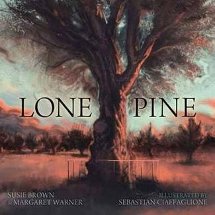Lone Pine by Susie Brown and Margaret Warner

Ill. by Sebastian Ciaffaglione. Little Hare, 2012 .ISBN
9781921541346.
In 1915, on a Turkish hillside a lone pine stood in a barren
wasteland above a fierce battle being waged between the Turks and
ANZACs, a conflict that has become part of Australia's history and
identity. In 1934, a sapling grown from that lone pine was planted
in the grounds of the Australian War Memorial in Canberra,
Australia's national capital. In 2012, that tree still stands tall
in beautiful, lush surroundings in memory and recognition of the
events of 1915.
Lone Pine is the true story of that journey. From a soldier looking
for his brother, a mother mourning the loss of her son, a gardener
understanding both the significance and the vision, a Duke
performing a ceremonial duty we learn of how a tiny pine cone from
that solitary tree has become such a symbol in our commemorations.
Told in simple prose against a backdrop of muted but magnificent
artistry which you can view
, the story is both moving and haunting. The soldier's mother plants
three seeds but only two saplings survive, just like her sons;
fierce storms batter the sapling the day it is planted at the AWM,
just as war clouds started rumbling around Europe once again; it
survives to stand tall and strong despite the storms it has to
weather, just as our hope for peace does. The continuity of life
through the pine tree echoes the seasons and cycles of human life.
Jointly written by a teacher librarian and a teacher, there is a
real understanding of how to engage the target audience and tell a
true story that is not just a recount of an historical event.
Accompanying the story are notes about the events it depicts
including more information about the tree itself which reinforce the
theme of the renewal and continuity of life. As well as the sapling
planted at the AWM, its twin was planted as a memorial to the fallen
brother in Inverell, and even though this has since been removed
because of disease, its son lives on at Inverell High School,
planted by the fallen soldier's nephew. Two trees propagated from
the pine at the AWM were taken to the Gallipoli Peninsula and
planted there by a group of ANZACs in 1990.
There is much more about the tree and its
descendants and teaching
notes are available that will take the students well beyond
the story of a remarkable tree. With the resurgence of the
significance of ANZAC Day in the understanding of our young, and a
pilgrimage to the Dawn Service at ANZAC Cove becoming a must-do,
life-changing event, the story of the lone pine deserves to be
better known, and this wonderful book HAS to be a part of any school
library's ANZAC collection.
Barbara Braxton